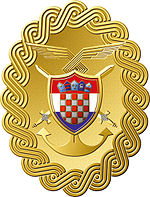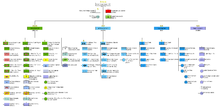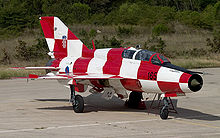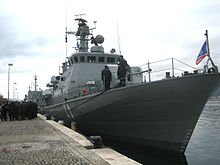- Military of Croatia
-
"Croatian Armed Forces" redirects here. For other uses, see Croatian Armed Forces (disambiguation).
Armed forces of the Republic of Croatia
Oružane snage Republike Hrvatske
Croatian Armed Forces emblemService branches Croatian Army
Croatian Navy
Croatian Air Force and DefenseLeadership Commander-in-Chief President Ivo Josipović Defence Minister Davor Božinović Chief of staff General Drago Lovrić Manpower Military age 18 years of age (voluntary) Conscription Abolished in 2008 Available for
military service1,035,712 (2008 est.), age 15–49 Fit for
military service771,323 (2008 est.), age 15–49 Reaching military
age annually27,500 (2008 est.) Active personnel 18,400 (ranked 100th) Reserve personnel 6,000 Deployed personnel  Afghanistan - 315
Afghanistan - 315
Expenditures Budget 875 millionUSD
4.87 billion HRK [1]Percent of GDP 1.52% (2009) Industry Domestic suppliers Đuro Đaković (armored vehicles)
HS Produkt (small arms)Foreign suppliers
 Sweden
Sweden
 Switzerland
Switzerland
 Italy
Italy
 Finland
Finland
 United States
United States
 Canada
Canada
 Norway
Norway
 Israel
Israel
 Germany
GermanyRelated articles History Military history of Croatia
Ban Josip Jelačić
Nikola Šubić Zrinski
Croatian War of Independence
Croatian National Guard
War in Bosnia and HerzegovinaRanks Croatian military ranks Croatian military is officially called Armed Forces of the Republic of Croatia (Croatian: Oružane snage Republike Hrvatske - OSRH) and it consists of three branches:
- Croatian Army (Hrvatska kopnena vojska)
- Croatian Navy (Hrvatska ratna mornarica)
- Croatian Air Force and Defense (Hrvatsko ratno zrakoplovstvo i protuzračna obrana)
Contents
Strength
The total number of active military personal in Croatian Armed Forces stands at 18,400 and additionally there are 1,600 civilians working in various service branches of the armed forces.
- HQ/support/services personal account for 3,000 service personal,
- Navy 1,800 serviceman,
- Air Force 2,000 serviceman,
- Army 12,000 service personal (includes 2,000 Volunteers)
- 1,600 civilians
- Total 20,400 personal (this number is not inclusive of 6,000 first level alert reservist)
Total available male manpower aged 16–49 number 1,035,712, of which 771,323 are technically fit for military service. Male citizens are now no longer subject to compulsory military service since January 1, 2008. However, the last generation of 2007 servicemen was also absolved of compulsory service by an act from then Minister of Defense Berislav Rončević.[2]
Budget
The Croatian military budget for the past 6–7 years was kept below 2% of GDP, a vast difference from the 1990s when defense expenditure represented a major stake in Croatian Budgetary expenditure due to the Croatian War of Independence. For example, 1995 Croatian defense budget stood at 12.4 billion Croatian Kuna or just over 12% of GDP, which was also the highest defense expenditure ever.
Defense Expenditures in recent years (example years - source Croatian MOD);
- 2000: 4.768 bln HRK - 3.13% of GDP[3]
- 2001: 4.909 bln HRK - 3.01% of GDP[3]
- 2002: 4.659 bln HRK - 2.64% of GDP[3]
- 2003: 4.814 bln HRK - 2.54% of GDP[3]
- 2004: 4.102 bln HRK - 2.00% of GDP[3]
- 2005: 4.106 bln HRK - 1.87% of GDP[3]
- 2006: 4.20 billion Croatian Kuna - 1.67% of GDP
- 2007: 4.63 billion Croatian Kuna - 1.69% of GDP
- 2008: 5.35 billion Croatian Kuna - 1.79% of GDP
- 2009: 5.11 billion Croatian Kuna - 1.52% of GDP
- 2010: 4.81 billion Croatian Kuna - 1.45% of GDP
- 2011: 5.03 billion Croatian Kuna - 1.46% of GDP (projected)
According to the 2006-2015 long-term defense plan the country's military expenditures were set to rise to 1.80% of GDP in 2008, to 1.85% in 2009 and finally to remain steady at 2.00% from 2010 onwards as suggested by NATO. However, due to the economic crisis, expenditures for 2009 were kept well bellow the envisaged level.
According to government's economic plans for the 2010-2012 period, Croatian military expenditures are to remain somewhere around 1.35-1.40%. This would have meant that Croatia would have spent the least amount of money on its armed forces in its own history. Because of this sharp fall, there was concern about postponements or even cancellation of many modernization projects.
Again, however, contrary to expectations, the military expenditure for 2011 was instead raised up to 4.96 billions kuna, +4.6% more than the previous year, slightly more of 1.5% of GDP.[4]
It have also to be noted that the parallel completion of the planned process of military personnel downsizing, would hopefully allow a sensibly more efficient allocation of monetary resources.
Defence reforms
 The M-95 Degman, Croatia's main battle tank
The M-95 Degman, Croatia's main battle tank
The Croatian government has implemented series of defence reforms with several important goals. These goals are meant to reduce the number of personnel serving in the military. By 2010, the Croatian military will have 20,400 military personnel including 1600 civilian personnel.
- Plans to reduce the number of servicemen and non-combat personnel;
- Plans to cut the army from its current number of 16,000 personnel to 12,000 personnel.
- Plans to cut the number of Air Force personnel to 2,000 from the current number of 2,700.
- Plans to cut the number of Naval personnel to around 1,800. (implemented)
- Reserve status personnel to be cut from 32,000 to 6,000 by 2010.
- Introduction of professional and voluntary service. (implemented)
Force 2010:
- Croatian Army: 10,000 + 2000 volunteers,
- Croatian Navy: 1,800
- Croatian Air Force: 2,000
- Support/logistics/Special Forces and HQ: 3,000
- Total active military personnel: 18,800
- Civilians: 1,600
Commander
The Commander-in-Chief of all Croatian armed forces in peace and war is the President of the Republic. The Commander-in-Chief prescribes the organization of the Croatian Armed Forces at the proposal of the Chief of General Staff, with consent of the Minister of Defence.
The Armed Forces consist of peacetime and wartime component. The peacetime component is composed of active military officers, civil servants and employees in the Croatian Armed Forces, cadets, and conscripts serving a 6-month national service and reservists when on military exercise. The wartime component of the Armed Forces is additionally composed of all other reservists.
The General Staff is part of the Ministry of Defense in charge of commanding, training and use of the Armed Forces. It also has a number of units under its direct command, including the Special Operations Battalion, Honor Guard Battalion and several others.
In peace, the Commander-in-Chief exercises his command through the Minister of Defense. In war and in cases where the Minister of Defense is not fulfilling orders, the Commander-in-Chief exercises his command directly through the General Staff Commander.
The Croatian Parliament exercises democratic control over the Armed Forces by adopting defense strategy, defense budget and defense laws.
Special Forces and Honour Guard
Special Operations Battalion (Croatian: Bojna za specijalna djelovanja or BSD) was founded on September 8, 2000 with merging of the Special Combat Skills Center and some personnel from the 1st Croatian Guards Corps (1. Hrvatski Gardijski Zdrug). The Battalion has 300 men. Today, it is one of the most elite units of the Croatian military, as well as being one of the best trained and equipped special forces units in the region.[5]
The Croatian General Staff exercises direct command over the battalion which thus elevated the unit to strategic level for quicker reaction and overall better and faster tactical and strategic situations. Also, this means that members of all three branches of the Croatian armed forces can apply for selection.
Other special operations units are Military Intelligence Battalion (Vojno-obavještajna bojna or VOB) and Special Military Police Company (Satnija specijalne vojne policije or SSVP).
Duties of Honour Guard are performed by Počasno zaštitna bojna (300 men), located at Zagreb in Tuškanac military base.[5]
Projects
Government plans to substantially modernize the Armed Forces at a cost of 4.0 billion USD (2007–2015). The modernization calls for a complete revamp of the armed forces so that it can face all the challenges of the 21st century.
Proposed Defence Programs and updates/upgrades:
Army
- Procurement of 126 Patria AMV 8x8 Modular APC/IFV - 850 million kuna (additional 120-150 vehicles might be ordered after 2012)
- Procurement of 94 Iveco LMV (Light Multi-role Vehicles) at cost of 220 million kuna. The army might purchase additional LMVs once more funds become available. Around 250-300 LMVs are needed.
- Procurement of advanced artillery systems, up to 24x 155 mm self-propelled howitzers are to be purchased before 2015 to replace obsolete 2S1 self-propelled howitzers, however the program is on the back burner as there are more important defense programs; procurement of new howitzers might need to be postponed for a few years. Swedish Bofors ARCHER Artillery System and German PzH 2000 are most likely candidates for this program. Cost of program - 1.2 billion kuna.
- Procurement of 550 5-ton army trucks, 200 7.5-ton military trucks and 300 4WD vehicles - program is in a full swing and first batch of MAN (150), Mercedes (30) and Iveco (50) military trucks was delivered. Croatian Army also ordered large numbers of new 4WD vehicles, Mercedes-Benz G-Class - 120, Land Rover Wolf - 60, Toyota Land Cruiser - 50, Nissan Navara - 50, got delivered in 2005-2007. Cost of program - 570-580 million kuna.
- Modernization of M-84A and M-84A4 Snajper MBTs and upgrade to M-84D and M-95 Degman standard. Program calls for an upgrade and modernization of 75 existing tanks and procurement of additional 29 new tanks over next 4 years due to a plan which requires Croatia to operate at least 104 modern tanks before 2015. Cost of program - 850 million kuna.
- Introduction of new 5.56 mm NATO standard VHS assault rifle. Cost of program - 200 million kuna (20,000 rifles with day/night sights and grenade launchers)
- Scores of smaller programs, communication equipment, night vision capability, electronic sensors, NBC equipment, battlefield management systems and modernization of artillery systems with new sights and electronic fire control systems.
Air Force
- Procurement of 10-12 Mi-171Sh transport helicopters and all associated spare parts and equipment. Helicopters are equipped up to a NATO standards with mostly western avionics. Cost of Program - 380 million kuna, paid for in form of Russian debt to Croatia.
- Procurement of 5 Zlin 242L basic trainers. Cost of program - 10 million Croatian kuna.
- Procurement of Advanced short to medium range NATO SAM systems and modernization of existing Russian-made Igla SAMs. Croatia needs 12 Short to medium range SAM batteries (radar/command vehicles + 2 luncher vehicles). Cost of program - 700-850 million kuna.
- Procurement of modern jet fighters, Croatia plans to modernize its air force with the introduction of 12 multirole fighters. In the competition are Saab JAS 39 Gripen, Eurofighter Typhoon, Dassault Rafale, General Dynamics F-16 Fighting Falcon and Mikoyan MiG-35.[6][7] Program might be postponed for a year or two as a result of ongoing global economic crisis and recent decision that CAF needs at least 18-24 fighters to effectively patrol Croatian airspace. As an interim solution, additional 6-7 MiG-21s stored back in 2003 might be modernized and reinstated into service in 2009. Cost of fighter procurement program - 5 billion kuna.
- Modern radar network. New modern radar network was put in to use in 2007 - AN/FPS-117 radar network consisting of 5 radar stations across Croatia. Cost of program - 1800 million Croatian kuna, program was initiated in 1998 and paid for by Croatian MOD in 1999.
- Procurement of 2 additional Canadair CL-415 fire bombers and 5 Air Tractor AT-802 - cost of program - 450 million kuna. It has to be noted that this procurement wasn't planned and money was acquired from a surplus in the national budget.
- Additional programs are also being considered, additional utility, ASW, SAR and police helicopters as well as few medium transport aircraft for the needs of several peacekeeping operations.
Navy plans are still being worked on but present plans call for a medium expansion of the naval force.
- 10 new patrol boats, locally built, 40 meters in length. Cost of program 500 million kuna.
- 4 new corvettes - 88–120 meters in length. Cost of program 3000 million kuna.
- Overhaul of existing 2 King class fast attack crafts, including new engines. Cost of program - 40 million kuna.
- Upgrading RBS-15 missiles to latest standard. - Cost of program - 120 million kuna.
Programs under revision
- BVP M-80A - Program is at the standstill and might no longer receive any upgrades, Croatian MOD stated, that it will replace its M80's with the modern western IFV when funds become available. Most likely contender for this program is Patria AMV in IFV configuration.
International cooperation
On April 1, 2009 Croatia joined NATO and is also an official candidate country to become the 28th member of the European Union. The Croatian Armed Forces participate in many (military) aspects of both organizations as well as actively participate in many UN peacekeeping operations worldwide.
Current Mission Organization Country Nr. of personnel United Nations Military Observer Group in India and Pakistan UNMOGIP United Nations India and Pakistan 7 Kosovo ForcesKFOR NATO Kosovo 20 European Union mission in Chad EUFOR Tchad/RCA European Union Chad 15 International Security Assistance Force - ISAF NATO Afghanistan 299 United Nations Mission for the Referendum in Western Sahara MINURSO United Nations Western Sahara 3 United Nations Mission in Liberia - UNMIL United Nations Liberia 3 United Nations Disengagement Observer Force - UNDOF United Nations Golan Heights - Syria and Israel 95 United Nations Operation in Côte d'Ivoire UNOCI United Nations Côte d'Ivoire 3 United Nations Stabilization Mission in Haiti MINUSTAH United Nations Haiti 3 United Nations Peacekeeping Force in Cyprus UNFICYP United Nations Cyprus 3 Former Mission Operation Country Organization Nr. of personnel Time United Nations Observer Mission in GeorgiaUNOMIG United Nations Georgia 3 United Nations Mission of Support in East TimorUNMISET United Nations East Timor 3 United Nations Mission in Sierra Leone - UNAMSIL United Nations Sierra Leone 10 United Nations Mission in Ethiopia and Eritrea - UNMEE United Nations Ethiopia and Eritrea 7 International military exercises Country Organization Nr. of personnel Time Noble Midas 2007 9000 2007 Gallery
See also
- Croatian military ranks
- Croatian War of Independence
- List of Croatian soldiers
- Military history of Croatia
- Military Security and Intelligence Agency
- Croatian Ministry of Defence
References
- ^ [1]
- ^ Nema više obveznog vojnog roka – NACIONAL
- ^ a b c d e f Alvir, Marija (March 2005). "Proračun MORH-a neće više padati" (in Croatian). Hrvatski vojnik (Croatian Ministry of Defence). http://www.hrvatski-vojnik.hr/hrvatski-vojnik/0242005/budimir.asp. Retrieved 9 September 2011.
- ^ [2]
- ^ a b http://www.morh.hr/katalog/documents/dpr_final.pdf
- ^ Saab details Gripen proposal to Croatia by Dino Kucic
- ^ Fighters - from boom to gloom?
External links
- Croatian Armed Forces Official website
- Croatian Forces International Volunteers Association official website
- [3] - Defense planning and procurement.
- [4] - long term planning and long term defense strategy
Leadership Commander-in-chief: President of Croatia • Minister of Defense • General Staff of Croatia
Organization BranchesCommandsSupport Command • Training and Doctrine Command • VSOA
ForcesBSD • Motorized Guards • Armoured Guards • Navy Flotilla • Coast Guard
Military history Army history • Navy history • Aviation history
Uniforms and Insignia Uniforms • Ranks • Orders and medals
Military of Europe Sovereign
states- Albania
- Andorra
- Armenia
- Austria
- Azerbaijan
- Belarus
- Belgium
- Bosnia and Herzegovina
- Bulgaria
- Croatia
- Cyprus
- Czech Republic
- Denmark
- Estonia
- Finland
- France
- Georgia
- Germany
- Greece
- Hungary
- Iceland
- Ireland
- Italy
- Kazakhstan
- Latvia
- Liechtenstein
- Lithuania
- Luxembourg
- Macedonia
- Malta
- Moldova
- Monaco
- Montenegro
- Netherlands
- Norway
- Poland
- Portugal
- Romania
- Russia
- San Marino
- Serbia
- Slovakia
- Slovenia
- Spain
- Sweden
- Switzerland
- Turkey
- Ukraine
- United Kingdom
- Vatican City
States with limited
recognition- Abkhazia
- Kosovo
- Nagorno-Karabakh
- Northern Cyprus
- South Ossetia
- Transnistria
Other entities - European Union
- Sovereign Military Order of Malta
North Atlantic Treaty Organization (NATO) History 
Structure Members Categories:
Wikimedia Foundation. 2010.











